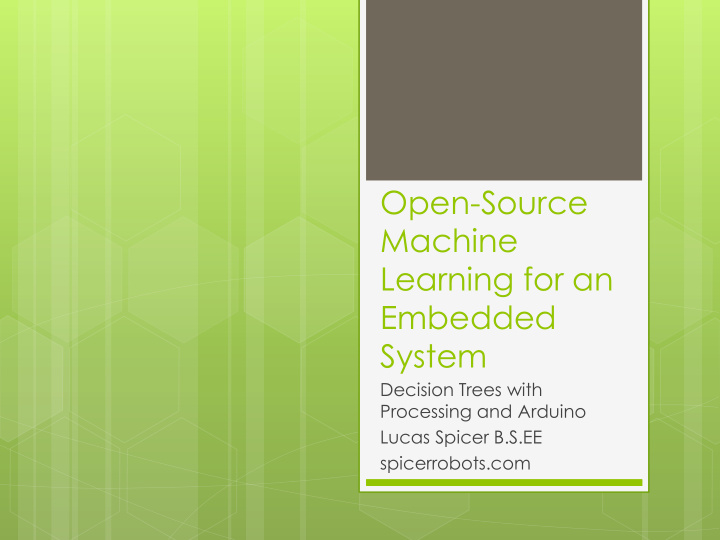



Open-Source Machine Learning for an Embedded System Decision Trees with Processing and Arduino Lucas Spicer B.S.EE spicerrobots.com
http://karenswhimsy.com/tree-clipart.shtm
Machine Learning (ML) A branch of Artificial Intelligence which deals with algorithms which allow computers to generalize example data probability distributions in order to improve their behaviors ML traditionally attempts to improve complex relationship recognition from limited data and to provide human intelligible insight into those relationships Examples: Netflix Suggestions, Google Instant Search, Credit Card Fraud Detection, etc.
The Challenge Because Machine Learning is traditionally performed on expensive proprietary software systems (like Matlab) the goal for this project is: To use open-source free software to generate decision trees from arbitrary numbers of examples with arbitrary numbers of attributes and arbitrary numbers of levels of those attributes, as well as arbitrary numbers of output classes To provide source-code output to implement the generated decision trees on an open-source low cost embedded development system, as well as human readable or graphical output to explain and educate how the generation process works
Processing Processing is a free open-source programming language, development environment, and online community that promotes software literacy within the visual arts Processing was initially created to serve as a software sketchbook and to teach fundamentals of computer programming within a visual context http://processing.org
Processing Sketchbook IDE running the Decision Tree Generator
Arduino is an open-source electronics prototyping platform based on flexible, easy- to-use hardware and software. It's intended for artists, designers, hobbyists, and anyone interested in creating interactive objects or environments. http://arduino.cc
Decision Trees Root Node Outlook? Nodes (Tests) sunny rain overcast Humidity? Wind? Yes! normal high strong weak Yes! No! No! Leaf Nodes Yes! (Decisions)
function ID3 Input: (R: a set of non-target attributes, J. Ross Quinlan’s C: the target attribute, classic Decision S: a training set) returns a decision tree; begin If S is empty, return a single node with Tree Algorithm ID3 value Failure; If S consists of records all with the same value for the target attribute, Assumes Discrete return a single leaf node with that value; If R is empty, then return a single node Data Classes with the value of the most frequent of the values of the target attribute that are found in records of S; [in that case there may be be errors, examples Recursive Splitting that will be improperly classified]; is based on Let A be the attribute with largest Gain(A,S) among attributes in R; Entropy and Let {aj| j=1,2, .., m} be the values of attribute A; Information Gain Let {Sj| j=1,2, .., m} be the subsets of S consisting respectively of records with value aj for A; Return a tree with root labeled A and arcs labeled a1, a2, .., am going respectively to the trees (ID3(R-{A}, C, S1), ID3(R-{A}, C, S2), .....,ID3(R-{A}, C, Sm); Recursively apply ID3 to subsets {Sj| j=1,2, .., m} until they are empty end
Entropy is a Measure of Uncertainty in Data S is a data set p i is the proportion of the set from the i th class of S Zero Entropy occurs when the entire set is from one class The concept was introduced by Claude E. Shannon in his 1948 paper "A Mathematical Theory of Communication"
Information Gain is a Reduction in Entropy S is a data set A is a subset of S with a given attribute Goal is to test attributes which provide the maximum information gain for a given data set
Example Data Set Day Outlook Temperature Humidity Wind PlayTennis? 1 sunny hot high weak No 2 sunny hot high strong No 3 overcast hot high weak Yes 4 rain mild high weak Yes 5 rain cool normal weak Yes 6 rain cool normal strong No 7 overcast cool normal strong Yes 8 sunny mild high weak No 9 sunny cool normal weak Yes 10 rain mild normal weak Yes 11 sunny mild normal strong Yes 12 overcast mild high strong Yes 13 overcast hot normal weak Yes 14 rain mild high strong No 15 sunny hot normal strong No 16 sunny hot normal strong Yes
Example Decision Tree Output Calculations and Graphical Representation of Tree
Example Auto- Generated Arduino Function output from Processing Allows Arduino to implement the tree “grown” (trained) on a computer running Processing
Validation Key task for ML systems is to validate their ability to generalize from examples Data Set is partitioned into a training set and a validation set. Training set is used to build the decision tree and validation set is used to test its ability to generalize Validation on Fisher's Iris Data 96% % Correctly Validated 94% 92% 90% 88% 86% 84% 82% 80% 100% 90% 80% 70% 60% 50% 40% 30% 20% 10% 0% % of Examples Used to Build Tree
Applications Freely and easily available educational tool to instruct about machine learning Software library to give small robot hobbyists ability to make smarter, learning robots (or other embedded devices) Examples: smart watering can, obstacle avoiding robots, automatic failure diagnosis for small embedded devices, etc.
Recommend
More recommend